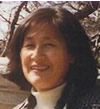The Harvard Family Research Project separated from the Harvard Graduate School of Education to become the Global Family Research Project as of January 1, 2017. It is no longer affiliated with Harvard University.
Interview With Sook Nyul Choi, Author of Halmoni and the Picnic
 |
| Sook Nyul Choi |
In addition to being a celebrated children's storybook author, you are a parent, a former schoolteacher, and a Korean American. How did each of these perspectives shape the story of Halmoni and the Picnic?
When I wrote Halmoni and the Picnic, I drew on my own experiences as a schoolteacher in New York City. I spent many years teaching all grades, from very young children to high schoolers. Whatever age group I taught, I tried to form a connection not only with the school children, but also with their families.
I would encourage children to invite their family members into the classroom and on class field trips. Sometimes students thought their family members wouldn't fit in, but I would tell them that parents, relatives, and especially grandparents have experienced a lot in life, can teach us a lot, and are a lot of fun to be with. I sent home notes inviting all the family members. The family members were so delighted that they were wanted—and we had so many wonderful experiences. While children in other classes were eating bologna sandwiches for lunch, the parents or grandparents of my students would bring in fresh fruit, baked goods, or even hot food to share for the children's lunches.
The parents and grandparents shared many wonderful stories with the children about how things were when they grew up—some in America and some in foreign countries. The family members also enjoyed getting to meet and talk with each other. We took many field trips together to Central Park and local historical sites like Theodore Roosevelt's birthplace.
What message would you hope that all children and families come away with after reading this book? In particular, what message would you hope children and families from diverse cultures come away with?
I want children to know that each of their family members is important and can make great contributions to a rich, fun learning experience. All family members, no matter what their cultural or ethnic background, have a great deal to contribute and can be welcomed and embraced by the learning community. Even if language appears to be a barrier at first, there are many ways to communicate across languages and include family members in a wonderful, diverse learning environment for all children.
Do you think children's stories can bring children, families, and schools together across differences? If so, how?
Yes, I think children's stories can make an important contribution toward bringing people together. A story can give a family the chance to sit together and start talking, opening up a conversation from a small insignificant event to what really matters to them. It provides a way to start a discussion. Before you know it, they're talking with each other about their feelings about the book, and they become closer. Similarly, in a school context, a story can help children open up their feelings to their teachers and classmates, or a story can help the class empathize with some of the challenges with which an individual student might be struggling. The storybook can act as a little ambassador of sorts.
In Halmoni and the Picnic you give a moving example of how a teacher helps students learn about cultures different from their own and makes a family member from a different culture feel comfortable. Based on your years of teaching and parenting, can you talk about what teachers can do to teach children about different cultures?
Teachers are incredibly important role models. Children always look to what their teachers are doing, how they respond to people, and how they react to different situations. By setting the example of embracing different cultures, being welcoming to new students, and celebrating different traditions, teachers send a powerful signal to students about how to value and learn from new experiences. Children tend to be comfortable doing what is familiar to them, but if they see a teacher trying something new, like tasting a new food or introducing a new tradition to the class, they are more willing to try it too. Simply by being open and receptive to new ideas, new people, and new cultures, teachers can be powerful role models and leaders in teaching tolerance and acceptance.
Your story also portrays a child as actively encouraging her grandmother's involvement in the school. What do you see as children's roles in connecting home and school?
If supported and encouraged to do so, children can act as a bridge to help teachers and families understand each other. When I was a teacher, my schoolchildren came from many different types of families—some were raised by single parents, some were adopted, some were raised by their grandparents. Because they had an accepting, open environment in the classroom, children felt comfortable talking about their families and their backgrounds. That helped us teachers understand better the challenges and concerns those families might be facing. Teachers cannot do everything alone. We need children and parents and friends and others to work together to build a learning community. We all need each other.
Reference
Choi, S. N. (1993). Halmoni and the picnic. Boston: Houghton Mifflin. In the story, a student worries that her classmates will make fun of her Korean grandmother, Halmoni, who has agreed to chaperone the class at a picnic in Central Park in New York City.
Interview conducted by Holly Kreider, March 2004

